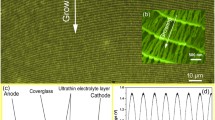Abstract
NO x sensing properties of SnO2-xCr2O3 as a varistor-type gas sensor have been investigated in the temperature range of 200–600°C. The breakdown voltage of SnO2 shifted to a higher electric field upon exposure to NO2 at 300–500°C, and the largest breakdown voltage shift, i.e. the highest NO2 sensitivity was observed at 400°C. In contrast, the direction of the breakdown voltage shift in NO varied with temperature: the breakdown voltage shifted to a lower electric field at 300°C, but to a higher electric field at 500°C, and remained almost unchanged at 400°C. The NO2 sensitivity of SnO2 was superior to the NO sensitivity at every temperature, and then the SnO2 exhibited good selectivity to NO2 at 400°C. The breakdown voltage of Cr2O3 shifted in the reverse direction upon exposure to NO and NO2, in comparison with those observed with SnO2, owing to its p-type semiconductivity. Thus, Cr2O3 also exhibited certain sensitivity to both NO and NO2 at 200°C, being more sensitive to NO2, though the sensitivities decreased drastically at temperatures higher than 300°C. The addition of 5.0 wt% Cr2O3 to SnO2 resulted in a significant improvement of NO and NO2 sensitivities at 600°C, being accompanied by an increase in the breakdown voltage in air. Especially, the NO sensitivity was superior to the NO2 sensitivity in the concentration range of 20–100 ppm, and then SnO2 mixed with 5.0 wt% Cr2O3 was found to be the most suitable candidate for a NO sensor among the sensors tested. The increase in the breakdown voltage in air induced by the Cr2O3 addition was confirmed to arise from both the decrease in the particle size of SnO2 and the formation of micro p-n junctions at grain boundaries. The decrease in the particle size was also responsible for the increased NO and NO2 sensitivities, but the p-n junctions were suggested to play a more important role in promoting and stabilizing the chemisorption of NO at higher temperatures.
Similar content being viewed by others
References
M. Akiyama, J. Tamaki, N. Miura, and N. Yamazoe, Denki Kagaku (presently Electrochemistry), 64, 1285 (1996).
M. Akiyama, J. Tamaki, N. Miura, and N. Yamazoe, Chem. Lett., 1991, 1611 (1991).
C. Cantalini, M. Pelino, H.T. Sun, M. Faccio, S. Santucci, L. Lozzi, and M. Passacantando, Sensors and Actuators B, 35-36, 112 (1996).
M. Penza, M.A. Tagliente, L. Mirenghi, C. Garardi, C. Martucci, and G. Cassano, Sensors and Actuators B, 50, 9 (1998).
J. Tamaki, T. Nagaoka, Y. Yamamoto, and M. Matsuoka, Trans. Inst. Elect. Eng. Jpn., 188-E, 125 (1998) (in Japanese).
N. Miura, G. Lu, M. Ono, and M. Yamazoe, Solid State Ionics, 117, 283 (1999).
F. Lin, Y. Takao, Y. Shimizu, and M. Egashira, Denki Kagaku (presently Electrochemistry), 61, 1021 (1993).
F. Lin, Y. Takao, Y. Shimizu, and M. Egashira, Sensors and Actuators B, 24/25, 843 (1995).
F. Lin, Y. Takao, Y. Shimizu, and M. Egashira, J. Am. Ceram. Soc., 78, 2301 (1995).
M. Egashira, Y. Shimizu, Y. Takao, and Y. Fukuyama, Sensors and Actuators B, 33, 89 (1996).
Y. Shimizu, E. Kanazawa, Y. Takao, and M. Egashira, Trans. Inst. Elect. Eng. Jpn., 117-E, 560 (1997).
Y. Shimizu, F. Lin, Y. Takao, and M. Egashira, J. Am. Ceram. Soc., 81, 1633 (1998).
Y. Shimizu, E. Kanazawa, Y. Takao, and M. Egashira, Sensors and Actuators B, 52, 38 (1998).
T. Hyodo, E. Kanazawa, Y. Takao, Y. Shimizu, and M. Egashira, Electrochemistry, 68, 24 (2000).
M. Egashira, Y. Shimizu, Y. Takao, and S. Sako, Sensors and Actuators B, 35/36, 62 (1996).
Y. Shimizu, T. Iwanaga, Y. Takao, and M. Egashira, Trans. Inst. Elect. Eng. Jpn., 118-E, 130 (1998).
T. Hyodo, K. Okamoto, Y. Takao, Y. Shimizu, and M. Egashira, Trans. Inst. Elect. Eng. Jpn., 119-E, 103 (1999).
T. Hyodo, N. Nakashima, Y. Shimizu, and M. Egashira, in Proc. of the 4th East Asian Conf. on Chemical Sensors, Nov. 23-26, 1999, Hsinchu, Taiwan (1999), p. 113.
Author information
Authors and Affiliations
Rights and permissions
About this article
Cite this article
Shimizu, Y., Nakashima, N., Hyodo, T. et al. NOx Sensing Properties of Varistor-Type Gas Sensors Consisting of Micro p-n Junctions. Journal of Electroceramics 6, 209–217 (2001). https://doi.org/10.1023/A:1011448513611
Issue Date:
DOI: https://doi.org/10.1023/A:1011448513611




